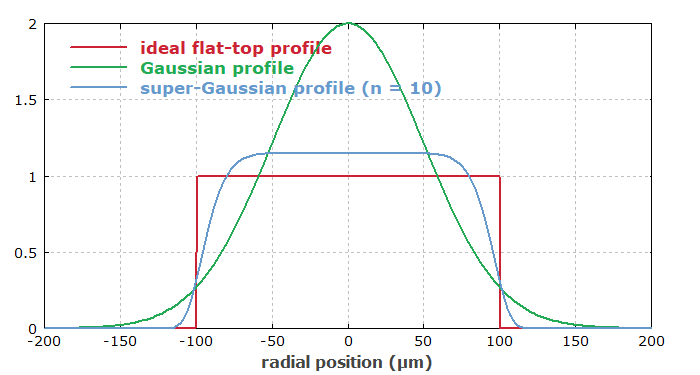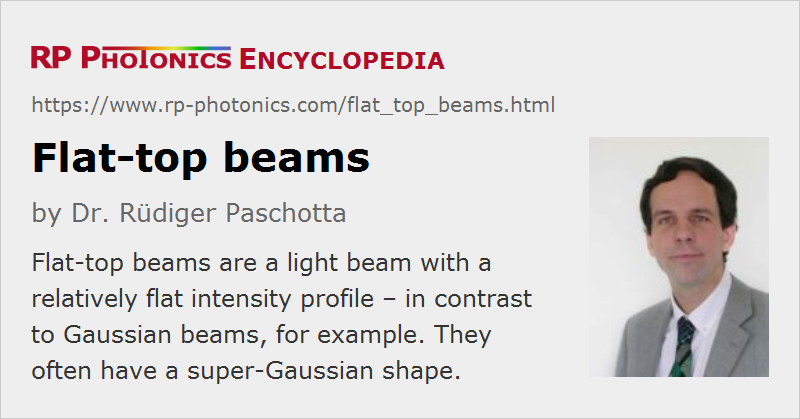Flat-top Beams
Definition: a light beam with a flat intensity profile
Alternative term: top-hat beams
More general terms: light beams, laser beams
How to cite the article; suggest additional literature
Author: Dr. Rüdiger Paschotta
A flat-top beam (or top-hat beam) is a light beam (often a transformed laser beam) having an intensity profile which is flat over most of the covered area. This is in contrast to Gaussian beams, for example, where the intensity smoothly decays from its maximum on the beam axis to zero. Such beam profiles are required for some laser applications. For example, one requires a constant intensity over some area in some techniques for the processing of semiconductor wafers and other materials. Also, nonlinear frequency conversion at very high power levels can be more efficient when performed with flat-top beams.

Typically, however, a flat-top beam profile still has some smooth edges, so that it can be approximated with a supergaussian profile, rather than a rectangular profile. A supergaussian intensity profile of order n is defined by the following equation:

The higher the order, the steeper are the edges of the profile.
Flat-top beams can be coherent, having smooth phase profiles. However, flat-top beams made with certain beam homogenizers may be spatially incoherent, having rather complicated phase profiles.
Propagation of Coherent Flat-top Beams
Note that in contrast to a Gaussian beam, a flat-top beam is not a free-space mode. This means that during propagation in free space, the shape of the intensity profile will change. The steeper the edges of the intensity profile are, the more rapidly will such changes occur. Figure 2 shows a simulated example for an initially supergaussian beam profile with flat wavefronts.

Of course, that change of beam profile may be negligible within the distance to the application. For beams with larger diameter and not too steep edges of the intensity profile, the beam size and shape may stay approximately constant.
Generation of Flat-top Beams
In many cases, a flat-top beam is obtained by first generating a Gaussian beam from a laser and then transforming its intensity profile with a suitable optical element. There are different kinds of beam homogenizers to do that transformation; some are based on diffractive optics.
Questions and Comments from Users
Here you can submit questions and comments. As far as they get accepted by the author, they will appear above this paragraph together with the author’s answer. The author will decide on acceptance based on certain criteria. Essentially, the issue must be of sufficiently broad interest.
Please do not enter personal data here; we would otherwise delete it soon. (See also our privacy declaration.) If you wish to receive personal feedback or consultancy from the author, please contact him e.g. via e-mail.
By submitting the information, you give your consent to the potential publication of your inputs on our website according to our rules. (If you later retract your consent, we will delete those inputs.) As your inputs are first reviewed by the author, they may be published with some delay.
See also: Gaussian beams, beam shapers, beam homogenizers, The Photonics Spotlight 2010-04-08
and other articles in the category general optics
 |




If you like this page, please share the link with your friends and colleagues, e.g. via social media:
These sharing buttons are implemented in a privacy-friendly way!